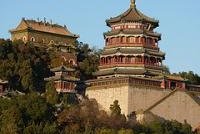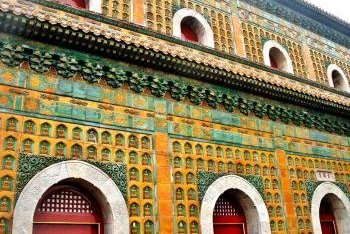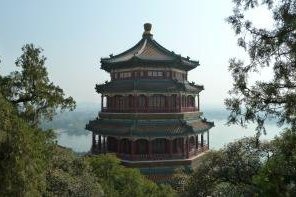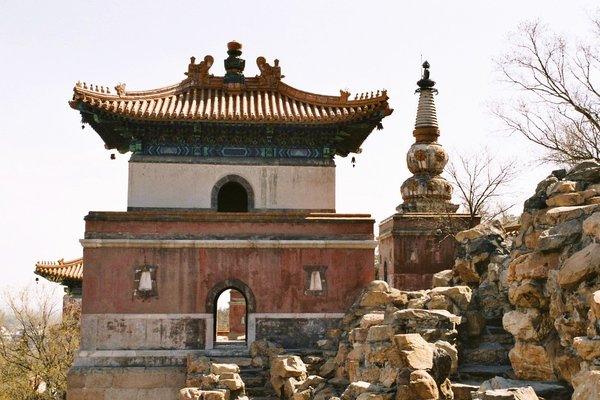China
Summer Palace
The Summer Palace, an Imperial Garden in Beijing, is a masterpiece of Chinese landscape garden design that is noted for its harmony and large scale.
This "New” Summer Palace landscape is dominated by Longevity Hill and Kunming Lake. In addition to halls and pavillions that provided political and administrative functions, it contains large areas for recreational use to enjoy views and spiritual contemplation. The garden has had a major influence on subsequent oriental garden art and culture.
Community Perspective: Not to be confused with the “Old” Summer Palace which is in ruins, this large site provides magnificent views and the boat trips are good as well. “If strolling around the lovely pavilions doesn't convince you that you're in the heart of Chinese culture, nothing will.”
Site Info
Official Information
- Full Name
- Summer Palace, an Imperial Garden in Beijing (ID: 880)
- Country
- China
- Status
-
Inscribed 1998
Site history
History of Summer Palace
- 1998: Inscribed
- Inscribed
- Type
- Cultural
- Criteria
- i
- ii
- iii
Links
- UNESCO
- whc.unesco.org
- Official
All Links
UNESCO.org
- whc.unesco.org — whc.unesco.org/
Official Website
Forum Discussion
- worldheritagesite.org — Locations of Beijing WHS
News Article
- Oct. 22, 2018 news.cgtn.com — Widespread outrage as foreign tourists damage ancient wall in Summer Palace
- Sept. 23, 2015 shanghaidaily.com — Tibetan relics from Norbulingka on exhibition in Beijing's Summer Palace
Travel Guides
- travelchinaguide.com — Summer Palace
Community Information
- Community Category
- Secular structure: Palace
Travel Information
Recent Connections
-
Perfect Inscriptions
1998 -
On Banknotes
Longevity Hill on ¥20 First Series (Jul… -
In Video Games
Age of Mythology: Chinese: Nü Wa: the S…
Connections of Summer Palace
- Individual People
-
-
Earls of Elgin
The 8th Earl of Elgin (1811-1863). In 1857 he became the British High Commissioner to China. During the Anglo French invasion of Beijing in 1860 he was involved in the decison making which led to the damage and ransacking of the Summer Palace (The British troops involved were led by his brother!) - as well as the destruction of the Old Summer Palace. The former (but not the latter) was rebuilt. -
Elias Burton Holmes
-
General Gordon
Was present, as a 27 year old captain in 1860 at the destruction of the Old Summer Palace "We went out, and, after pillaging it, burned the whole place, destroying in a vandal-like manner most valuable property which [could] not be replaced for four millions. We got upward of ?48 apiece prize money...I have done well. The [local] people are very civil, but I think the grandees hate us, as they must after what we did the Palace. You can scarcely imagine the beauty and magnificence of the places we burnt. It made one?s heart sore to burn them; in fact, these places were so large, and we were so pressed for time, that we could not plunder them carefully. Quantities of gold ornaments were burnt, considered as brass. It was wretchedly demoralising work for an army."
-
- Geography
-
-
Located in a Capital City
Beijing (Capital of China)
-
- Trivia
-
-
On Banknotes
Longevity Hill on ¥20 First Series (July 1949, October 1949), ¥100 First Series (February 5, 1949, March 20, 1949), ¥200 First Series (March 20, 1949) -
Opera
Nixon in China by J Adams. Act II Scene I. Visited by Pat Nixon. Sings aria in the Gate of Longevity and Goodwill -
In Video Games
Age of Mythology: Chinese: Nü Wa: the Summer Palace
-
- History
-
-
Eunuchs
-
Anglo Chinese Relations
The Old Summer Palace was destroyed by Anglo French troops during the Second Opium War in 1860. The New Summer Palace was destroyed on the same occasion and then again in 1900 during the Eight Nation alliance (UK, Austria-Hungary, France, Germany, Italy, Japan, Russia and US) to rescue foreigners besieged in the Legation quarter of Beijing during the Boxer Rebellion -
Summer residences
-
- Architecture
-
-
Chinese Garden
one of four Chinese great gardens -
Designed by Lei family
-
Octagons
Hall of Buddhist Incense
-
- Damaged
-
-
Destroyed during invasion
Lord Elgin 1860
-
- World Heritage Process
-
-
Perfect Inscriptions
1998
-
- Religion and Belief
-
-
Phoenix
Beijing Summer Palace has large Bronze statue of Phoenix in front of the Empress Cixi' hall
-
- Human Activity
-
-
Boats
Marble boat
-
- Constructions
-
-
Theatres and Opera Houses
Grand Theatre in "Garden of Virtuous Harmony" -
Thrones
in the Hall of Benevolence and Longevity, there is a big throne of Emperor. -
Notable Bridges
The Jade Belt Bridge is an 18th-century pedestrian Moon bridge. It is famous for its distinctive tall thin single arch. (wiki), and the Seventeen Arch Bridge (18th century), a 150 meter long stone bridge resembling a rainbow arching over the water
-
- WHS on Other Lists
-
-
Memory of the World
Qing Dynasty Yangshi Lei Archives
-
- Timeline
-
-
Built in the 18th century
"During the reigns of the Qing Emperors Kangxi and Qianlong (1663-1795) several imperial gardens were created around Beijing, the last of them being the Summer Palace, based on the Hill of Longevity and Kunming Lake in the north-western suburbs of the city.... Between 1750 and 1764 Emperor Qianlong created the Garden of Clear Ripples, extending the area of the lake" (AB)
-
- WHS Hotspots
- Literature & Film
-
-
History of the World in 100 objects
Prog 39 "Admonitions of the Instructress to the Court Ladies". (link) The British Museum web site talks of the painting's "arrival at the British Museum in 1903" and that it had been "in the imperial collection during the reign of the Qianlong emperor (1736-96)." China believes that the painting was looted from the Summer Palace in 1900 (link) -
Location for a classic movie
The Last Emperor (1987, Best Picture at Academy Awards, Best film at BAFTA, Best foreign film at César Awards)
-
News
- news.cgtn.com 10/22/2018
- Widespread outrage as foreign tour…
- shanghaidaily.com 09/23/2015
- Tibetan relics from Norbulingka on…
Recent Visitors
Visitors of Summer Palace
- 4lex
- AC
- Adam Hancock
- Adrian Turtschi
- Afshin Iranpour
- akacesfan
- Alberto Rodriguez Gutierrez
- Alejandro Lau
- Alexander Barabanov
- Alexander Lehmann
- Alexander Parsons
- Alex Goh
- Alex Marcean
- AlexSchedel
- Alikander99
- Ali Zingstra
- ALS
- A. Mehmet Haksever
- Anna Wludarska
- Ansitong
- Antonio J.
- Artur Anuszewski
- ashombob
- Aspasia
- Atila Ege
- AustralLights
- awestix
- AYB
- Bamse
- basementonline
- Bauchat
- BaziFettehenne
- bergecn
- Bill Koo
- Bill Maurmann
- Bin
- Bluewonder310
- Boj
- Bram de Bruin
- Carl Le Boeuf
- Carlo Sarion
- Casey
- CeeCeeSR
- cflw
- Chalamphol Therakul
- chenboada
- chenqtao
- Cheryl
- chiuliqi
- christof
- Christravelblog
- Cirene Moraes
- Claire Bradshaw
- Clyde
- Colossus
- Corinne Vail
- crilly
- Csaba Nováczky
- cutecid
- Cyberczar
- CynthiaW
- Daniela Hohmann
- dave wood
- David Marton
- Deffra
- Delphine Delaunay
- Dimitar Krastev
- DL
- Dolemite92
- Dorejd
- Dr. Caligari
- Drk9Stormy
- Dwight Zehuan Xiao
- Elisabeth Fransisca Situmorang
- eljx1988
- Els Slots
- EmmonsLiu
- Erfe91
- Erik Jelinek
- Eva Kisgyorgy
- Fan Yibo
- Federico P.
- Felicité
- Fernweh
- Filip Murlak
- finsbury_jo
- FK
- Fmaiolo@yahoo.com
- Frederik Dawson
- Garrett
- Geert Luiken
- George Gdanski
- GeorgeIng61
- Gernot
- Gilles
- giulio25
- halryder
- HaraldOest
- Harald T.
- Harry Mitsidis
- H Beswick
- Helios
- henrik_hannfors
- henryjiao18
- heywhatever2
- hotpickle
- Iain Jackson
- Ian Cade
- Ingrid
- inomusay
- Ivan Rucek
- Jacob Choi
- Jacob Otten
- Jan Zimmermann
- Jarek Pokrzywnicki
- Jasonfd247
- Javier
- Javier Coro
- Jawnbeary
- Jeanne OGrady
- Jeffrey Chai
- Jennjenn
- Jens
- Jezza
- JL
- J_neveryes
- Joel on the Road
- johnh10
- John Smaranda
- Jonas Hagung
- Jonas Kremer
- jonathanfr
- Jon Bauer
- Jon Eshuijs
- Jonoprout
- JoStof
- Joyce van Soest
- jxrocky
- KarenBMoore
- Karito Vies
- Kasper
- KeithBailey
- Ken DJ
- KentishTownRocks
- Kerékgyártó
- Kevin McFarland
- Kevin Padley-Knight
- kiank37
- Kjlauer
- KngAlaric
- Knut
- KoenigMarke
- Kristin
- Krzysztof B
- Kurt Lauer
- kutasp
- Kyle Magnuson
- Laetitia Yin
- Lameduck99
- Lars Bogstad
- Laurine
- Lazerway
- Lee Kai Loong
- Leonie Geurts
- Li
- Liamps91
- lichia
- Lillybett
- Linz
- ljowers
- Loic Pedras
- Lucio
- Ludvan
- Luis Filipe Gaspar
- Luj3904
- Luke LOU
- lynnz317@aol.com
- Maciej Gil
- Maciej Gowin
- Maja
- Malgorzata Kopczynska
- manman2411
- marcel staron
- Marcobrey
- Mariam
- Marinemajor
- Marlies van Wolfswinkel
- maryhattie
- Matthewrw
- Matthewsharris
- MaYumin
- MichaelH
- Michael Novins
- Michael Turtle
- Mihai Dascalu
- Mikko
- Miloš Tašković
- MMM
- Monica Tasciotti
- Morodhi
- MWaters66
- Naim Y
- nan
- NH1984
- Nicole Lampos
- Nihal Ege
- _oscar
- PabloNorte
- Palimpsesto
- Patrik
- Patrik_globe
- Paul Schofield
- Pchxiao
- PeterA
- PeterH
- Peter Lööv
- Petteri
- Philipp Leu
- Philipp Peterer
- phillipmeng
- Pieter Dijkshoorn
- Pink Bunny
- puessergio
- Qin Xie
- Ralf Regele
- Randi Thomsen
- ReallyDeepThoughts
- Reisedachs
- Remski
- Reza
- Rick Ohm
- Risson
- Rob Wilson
- Rodinia
- Roger Ourset
- Roman Bruehwiler
- Rubbie
- Rudegirl
- sakohju
- Samuel Turtschi
- Samy G
- Sandra!
- S. Anril Tiatco
- saraleonela
- Sclowitz
- Sergio Arjona
- Shandos Cleaver
- Shijie ZHU
- shwabb1
- sibariam
- Sijia
- SnakeGreen
- Solivagant
- Ssong.x
- Stanimir
- Stanislaw Warwas
- StaziG
- Sutul
- Svein Elias
- SymonMajewski
- Szabolcs Mosonyi
- Szucs Tamas
- Tamara Ratz
- Taotao Chen
- Tatiana Nikulnikova
- Thanneermalai L
- Thomas Buechler
- Thomas van der Walt
- Thorben
- Tim Allen
- Timonator
- Timothy C Easton
- tingmelvin
- tony0001
- Tony H.
- Traveling Girl
- trekkie900
- Twobaconsandaboston
- Velvetlapis
- Vernon Prieto
- Vincent Cheung
- VLabhard
- V&M
- VMThumper
- voyager
- Walter
- wantrain.
- Waxwing
- Weecheng
- Westwards
- Wo_ko
- Xander Huang
- Xiong Wei
- Xiquinho Silva
- Yang Chengyu
- Yongcheng Liu
- ZCTLife
- zfish
- Zhenjun Liu
- Zhou Yan
- Zizmondka
- Zoë Sheng
- Zos M
- ZZSong
Community Reviews
Show full reviews
I visited the Summer Palace in June 2024. The palace is located at the outskirts of Beijing so going there by public transport takes some time. I took the subway to Beigongmen station that makes you to access the palace grounds from the north entrance. This entrance was quite peaceful as bus tour groups seem to enter from the east entrance. I bought the ticket that allows access to all the different sites in the palace grounds but you can also opt for cheaper ticket that allows you to stroll just the gardens, which are still a lot to see.
Right after the entrance you're already on the first sight of interest, the Suzhou Street. This is a fake village made to look like the canals in Suzhou and it was made for the royals to play peasants doing their shopping. You can go walk on along the canal and even take a boat tour but I just admired this fun sight from the bridge that goes over it. After the Suzhou Street I started to climb over the Longevity Hill. I walked through the "Four Great Regions" which is a building complex resembling a Tibetan temple. After that I reached the top of the hill and started to hike down towards the Kunming lake and more central parts of the palace complex.
Climbing the hill in humid summer day was quite a sweaty activity but after reaching the lake I understood why the royals came here to …
Keep reading 0 comments
I visited this WHS in October 2013. There are so many places to explore and so many scenic spots to stop at that this site could easily take up a whole day to cover. The boat trips on Kunming Lake are pleasant and not too long. Visit at sunset to enjoy good lighting on Longevity Hill from Kunming Lake.
Keep reading 0 comments
The Summer Palace is a great place to spend a couple hours. The site is large enough that it seems far less busy than some of the other WHS in Beijing. What we see today is largely from 1886-1902. The Summer Palace is an incredible example of Chinese garden design, but its also one of the last great works of the declining Qing Dynasty.
The dynastic cycle ended only 12 years following the last rebuilding of the Summer Palace. This begs the question, how much was the current Summer Palace even used by Qing royalty? Famously, much of the funds (30 million Tael of silver) to re-build the palace were allegedly taken from the Qing Navy. Perhaps the Qing Dynasty was destined to collapse, regardless of Imperial folly and overindulgence.
What are we left to ponder strolling this beautiful palace and garden? For me it was a blend of Imperial grandeur and elegant design; yet the knowledge of the slow death of the Qing dynasty was there as well.
Keep reading 0 comments
Much to my surprise, this turned out to be my favourite site in Beijing. I had originally only scheduled a few hours to explore it, however a bit of a re-jig of my plans allowed a slightly more relaxed pace to my time in the Chinese capital.
I entered through the northern gate and had a huge amount of fun clambering up the hill and ducking into the huge amount of pavilions, follies and temples. This provided magnificent views over the lake that is the centre of the palace complex. My particular favourite was the Fragrant Buddha Pavillion which was magnificently decorated and offered hard won vistas from the top of the many flights of stairs.
After ducking off to a quiet spot for some lunch I treated myself to a cruise around the lake, which was massively enjoyable in the bright afternoon sun. Back on shore the marble boat and painted colonnade showed the massive artistic merit of the site as well as its monumental excess. Having already done a fair bit of exploring I was happy to wiz through the crowded central palace complex and enjoy a slow sunset watching the elderly men flying kites over the lake. This was an exceeding lovely way to spend my last afternoon in China, and to my surprise really let me enjoy a palace complex.
A thoroughly enjoyable and decadent place, that rewarded a leasuirly half day of exploring, my favourite WHS in Beijing.
[Site 8: Experience 8]
Keep reading 0 comments
There is now a subway line albeit an almost hour long train ride to the Summer Palace. After seeing the Forbidden city, this place strikes to me as an over-sized catering to the whims of the imperial Chinese emperors (which I guess really is!) This place is really interesting and is a very fascinating glimpse to the playful, artistic and sometimes crazy side of China's past rulers.
Keep reading 0 comments
The Summer Palace is a short taxi ride from the downtown area. The main halls (the "scenic spots") along with sections of the long corridor were being restored. One of the most tranquil sections is on either side of the 17-arches bridge, with its multicoloured flowers and boat piers.
Keep reading 0 comments
Even though the Summer Palace wasn't included in my tour, I made it a point to take the $5 taxi ride to the outskirts of Beijing to see it with my own eyes. It was a tranquil setting and thankfully free of tour groups. The dragon-shaped ferry across Kunming Lake with the scenic 17 Arch Bridge was worth the 50 cents to ride it. The buildings are tremendously ornate and if strolling around the lovely pavillions doesn't convince you that you're in the heart of Chinese culture, nothing will.
Keep reading 0 comments
Whilst the Summer Palace does not compare to the Forbidden City or the Great Wall, it is still an impressive site. As with the Forbidden City it is over-run with tour groups, but a little bit of effort climbing up to some of the more 'remote' parts of the site will reap rewards.
Whilst parts of the Palace were disgracefully vandalised by Anglo-French forces, it is interesting to note that more recent damage, from the Cultural Revolution (mainly the damage to the Buddhist section) is unrestored (and the blame unapportioned).
Keep reading 0 comments
This involves a nice bus trip (costing 0,15 euro) to the outskirts of Beijing passing its university. The 'new' Summer Palace is awesome. It's a group of buildings scattered on a hill and along the lakeside. I just couldn't stop taking pictures of the Temple of Wisdom. I think I've fallen in love with yellow and green tiles here in Beijing. And this temple has them all over, together with innumerable little Buddha statues (the ones closest to the ground missing their heads).
When I finally wanted a break after gazing at all the temples, pagodas, halls and so on, I stopped for lunch at the Palace's restaurant. After almost one week in Beijing I encountered them here for the first time: can't-be-bothered waitresses huddled together in a corner, hissing mei you when you order something not too spectacular. Enjoy the old-communist ways at the Tingliguan restaurant, with its yellow chairs, plastic table cloths, and darkened windows (no lights switched on). It was fun to see all western tourists peeking around the door, and immediately back off, while I enjoyed my shredded pork with green peppers.
The next day I went to the Old Summer Palace, which is now in ruins. It's like visiting ancient sites in Greece or Italy, though the Summer Palace is quite new compared to them. At most of the sites they placed a model to show how the buildings must have looked while they were still standing. They all look like reproductions of …
Keep reading 0 comments


